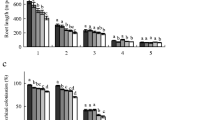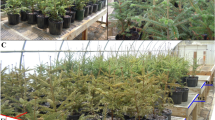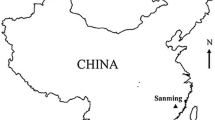Abstract
Plants under water stress alter their normal morphological and physiological processes. However, biomass allocation and nutrient use efficiency remain largely unknown under the interactive effect of irrigation and fertilization for many economically important conifer species. In this study, we compared biomass allocation and resources use efficiency of two-year-old (plug+1) containerized balsam fir [Abies balsamea (L) Mill.] ‘Cooks’ and concolor fir [Abies concolor (Gord. & Glend.) Lindl. Ex Hildebr.] ‘Cibola’, and one-year-old bare-root white pine [Pinus strobus L.] transplants grown under variable watering and fertilization conditions. In a controlled greenhouse setting, transplants were submitted to three irrigation levels and two fertilization rates in a factorial experimental design. Fir species, mainly concolor fir, had a greater capacity to utilize water resulting in decreased stem water potential than white pine, leading to increased aboveground growth and shoot-to-root (S/R) ratio. White pine transplants had a higher assimilatory nutrient efficiency, nutrient use efficiency (NUE), root weight ratio, and a lower nitrogen availability index than the two fir species, suggesting a better ability to tolerate water stress. The high rates of fertilization increased nutrient concentration more than growth, suggesting luxury consumption. These results indicate that white pine responds to drought stress by closing their stomata and decreasing their S/R ratio to limit physiological activities, while the two fir species exhibit increased water uptake via expanded fine root networks, increasing the NUE and S/R ratio. However, there was no clear trend for the irrigation and fertilization interaction for NUE for three species, making it difficult to generalize responses.




Similar content being viewed by others
References
Alam SM (1999) Nutrient uptake by plants under stress conditions. In: Pessarakli M (ed) Handbook of plant and crop stress. Marcel Dekker, New York, pp 285–313
Anderegg LDL, HilleRisLambers J (2016) Drought stress limits the geographic ranges of two tree species via different physiological mechanisms. Glob Chang Biol 22(3):1029–1045. https://doi.org/10.1111/gcb.13148
Andrews SF, Flanagan LB, Sharp EJ, Cai T (2012) Variation in water potential, hydraulic characteristics and water source use in montane Douglas-fir and lodgepole pine trees in southwestern Alberta and consequences for seasonal changes in photosynthetic capacity. Tree Physiol 32(2):146–160. https://doi.org/10.1093/treephys/tpr136
Anjum SA, Xie X-y, Wang L-c, Saleem MF, Man C, Lei W (2011) Morphological, physiological and biochemical responses of plants to drought stress. Afr J Agric Res 6(9):2026–2032
Aroca R (2012) Plant responses to drought stress. From morphological to molecular features. Springer, Berlin
Becker CA, Mroz GD, Fuller LG (1987) The effects of plant moisture stress on red pine (Pinus resinosa) seedling growth and establishment. Can J For Res 17(8):813–820
Bilderback TE (1999) Fertilizer choices and recommendations. Proc of NC State Nursery Short Course 1:28-29
Bongarten BC, Teskey RO (1987) Dry weight partitioning and its relationship to productivity in loblolly pine seedlings from seven sources. For Sci 33(2):255–267
Bréda N, Huc R, Granier A, Dreyer E (2006) Temperate forest trees and stands under severe drought: a review of ecophysiological responses, adaptation processes and long-term consequences. Ann For Sci 63(6):625–644. https://doi.org/10.1051/forest:2006042
Brunner I, Herzog C, Dawes MA, Arend M, Sperisen C (2015) How tree roots respond to drought. Front Plant Sci. https://doi.org/10.3389/fpls.2015.00547
Chen L, Wang C, Dell B, Zhao Z, Guo J, Xu D, Zeng J (2018) Growth and nutrient dynamics of Betula alnoides seedlings under exponential fertilization. J For Res 29(1):111–119
Cregg BM (2005) Conifer nutrition. Conifer Corner. Michigan Landscape magazine. https://www.canr.msu.edu/hrt/uploads/535/78626/conifernutrition.pdf. Accessed 14 February 2021
Cuny HE, Rathgeber CBK, Lebourgeois F, Fortin M, Fournier M (2012) Life strategies in intra-annual dynamics of wood formation: example of three conifer species in a temperate forest in north-east France. Tree Physiol 32(5):612–625. https://doi.org/10.1093/treephys/tps039
Espinoza SE, Martínez VA, Carlos RM, Ivkovic M, Santelices RE, Guerra FP, Cabrera AM (2014) Genetic control of growth, biomass allocation, and survival under drought stress in Pinus radiata D. Don seedlings. Tree Genet Genomes 10:1045–1054. https://doi.org/10.1007/s11295-014-0741-1
Fageria NK, Gheyi HR, Carvalho MCS, Moreira A (2016) Root growth, nutrient uptake and use efficiency by roots of tropical legume cover crops as influenced by phosphorus fertilization. J Plant Nutr 39(6):781–792. https://doi.org/10.1080/01904167.2015.1088020
Fernández ME, Gyenge JE, Varela S, Urquiza MD (2014) Effects of the time of drought occurrence within the growing season on growth and survival of Pinus ponderosa seedlings. Trees Struct Funct 28:745–756. https://doi.org/10.1007/s00468-014-0986-1
Fu-Sheng C, De-Hui Z, Narain SA, Guang-Sheng C (2005) Effects of soil moisture and soil depth on nitrogen mineralization process under Mongolian pine plantations in Zhanggutai sandy land, P. R. China. J For Res 16(2):101–104. https://doi.org/10.1007/bf02857899
Gilliam FS (2016) Forest ecosystems of temperate climatic regions: From ancient use to climate change. New Phytol 212:871–887. https://doi.org/10.1111/nph.14255
Gower ST, Vogt KA, Grier CC (1992) Carbon dynamics of Rocky Mountain Douglas-fir: influence of water and nutrient availability. Ecol Soc Am 6(1):43–65
Granier A, Reichstein M, Bréda N, Janssens IA, Falge E, Ciais P, Grünwald T, Aubinet M et al (2007) Evidence for soil water control on carbon and water dynamics in European forests during the extremely dry year: 2003. Agric For Meteorol 143(1–2):123–145. https://doi.org/10.1016/j.agrformet.2006.12.004
Grossnickle SC (2012) Why seedlings survive: influence of plant attributes. New For 43:711–738. https://doi.org/10.1007/s11056-012-9336-6
Guarnascheli AB, Garau AM, Lemcoff JH (2012) Water stress and afforestation: a contribution to ameliorate forest seedling performance during the establishment. In Water Stress, Intech: London, UK
Haase DL, Rose R (1995) Vector analysis and its use for interpreting plant nutrient shifts in response to silvicultural treatments. For Sci 41:54–66
Hamanishi ET, Campbell MM (2011) Genome-wide responses to drought in forest trees. Forestry 84(3):273–283. https://doi.org/10.1093/forestry/cpr012
Harfouchea A (2003) Retrospective early test for adult vigor of Pinus pinaster families grown under two water regimes. Implications for early selection. Ann For Sci 60:539–547. https://doi.org/10.1051/forest
Hermans C, Hammond JP, White PJ, Verbruggen N (2006) How do plants respond to nutrient shortage by biomass allocation? Trends Plant Sci 11(12):610–617. https://doi.org/10.1016/j.tplants.2006.10.007
Herzog C, Steffen J, Pannatier EG, Hajdas I, Brunner I (2014) Nine years of irrigation cause vegetation and fine root shifts in a water-limited pine forest. PLoS ONE 9(5):1–11. https://doi.org/10.1371/journal.pone.0096321
Ilyas M, Nisar M, Khan N, Hazat A, Khan AH, Hayat K, Fahad S, Ullah A (2021) Drought tolerance strategies in plants: a mechanistic approach. J Plant Growth Regul 40:926–944. https://doi.org/10.1007/s00344-020-10174-5
IPCC [Intergovernmental Panel on Climate Change] (2013) Near-term climate change: projections and predictability. In: Stocker TF, Qin D, Plattner G-K, Tignor M, Allen SK, Boschung J, Nauels A, Xia Y, Bex V, Midgley PM (eds) Climate change 2013: the physical science basis. Cambridge University Press, Cambridge, UK, pp 978–980
Jaleel CA, Manivannan P, Wahid A, Farooq M, Al-Juburi HJ, Somasundaram R, Panneerselvam R (2009) Drought stress in plants: a review on morphological characteristics and pigments composition. Int J Agric Biol 11(1):100–105
Koç İ (2021) Examining seed germination rate and seedlings gas exchange performances of some Turkish red pine provenances under water stress. Düzce Univ J Sci Tech 9(3):48–60
Kozlowski TT, Pallardy SG (2002) Acclimation and adaptive responses of woody plants to environmental stresses. Bot Rev 68(2):270–334. https://doi.org/10.1663/0006-8101(2002)068[0270:AAAROW]2.0.CO,2
Kulaç Ş, Nzokou P, Guney D, Cregg BM, Turna I (2012) Growth and physiological response of fraser fir [Abies fraseri (Pursh) Poir.] seedlings to water stress: seasonal and diurnal variations in photosynthetic pigments and carbohydrate concentration. HortScience 47(10):1512–1519
Landis TD, Dumroese RK, Haase DL (2010) The container tree nursery manual: Vol 7, seedling processing, storage, and outplanting. Agric Handbk 674. US Department of Agriculture Forest Service, Washington, DC, p 200
Larcher RJ (1995) Physiological plant ecology, 3rd edn. Springer, New York
Levitt J (1980) Responses of plants to environmental stresses: water, radiation, salt and other stresses. Academic Press, New York
Margolis HA, Brand DG (1990) An ecophysiological basis for understanding plantation establishment. Can J For Res 20:375–390
McMillin JD, Wagner MR (1995) Effects of water stress on biomass partitioning of ponderosa pine seedlings during primary root growth and shoot growth periods. For Sci 41(3):594–610
Miranda MT, Da Silva SF, Silveira NM, Pereira L, Machado EC, Ribeiro RV (2020) Root osmotic adjustment and stomatal control of leaf gas exchange are dependent on Citrus rootstocks under water deficit. J Plant Growth Regul 285:1–9
Moran E, Lauder J, Musser C, Stathos A, Shu M (2017) The genetics of drought tolerance in conifers. New Phytol 216(4):1034–1048. https://doi.org/10.1111/nph.14774
Nagarajan S, Nagarajan S (2010) Abiotic tolerance and crop improvement. In: Pareek A, Sopory S, Bohnert H (eds) Abiotic stress adaptation in plants, physiological, molecular and genomic foundation. Springer, The Netherlands, pp 1–11
Nehemy MF, Benettin P, Asadollahi M, Pratt D, Rinaldo A, McDonnell JJ (2021) Tree water deficit and dynamic source water partitioning. Hydrol Process 35(1):e14004
Nzokou P, Cregg BM (2010) Growth, biomass, and nitrogen use efficiency of containerized Fraser fir (Abies fraseri) as related to irrigation and nitrogen fertilization. HortScience 45(6):946–951
Piñol J, Sala A (2000) Ecological implications of xylem cavitation for several Pinaceae in the pacific northern USA. Funct Ecol 14(5):538–545. https://doi.org/10.1046/j.1365-2435.2000.00451.x
Sánchez-Salguero R, Ortíz C, Covelo F, Ochoa V, García-Ruíz R, Seco JI, Carreira JA, Merino JA, Linares JC (2015) Regulation of water use in the southernmost European fir (Abies pinsapo Boiss.): drought avoidance matters. Forests 6(6):2241–2260. https://doi.org/10.3390/f6062241
Seleiman MF, Al-Suhaibani N, Ali N, Akmal M, Alotaibi M, Refay Y, Dindaroglu T, Abdul-Wajid HH, Battaglia ML (2021) Drought stress impacts on plants and different approaches to alleviate its adverse effects. Plants 10(2):259
Setter TL (1990) Transport/harvest index: photosynthate partitioning in stressed plants. In: Cumming JR (ed) Stress responses in plants, adaptation and acclimation mechanisms. Wiley, New York USA, pp 17–36
Sheriff DW, Margolis HA, Kaufmann MR, Reich PB (1995) Resource use efficiency. In: Smith WK, Hinckley TM (eds) Resource physiology of conifers. Academic Press, San Diego, CA USA, pp 143–178
Shults P, Nzokou P, Koc I (2020) Nitrogen contributions of alley cropped Trifolium pratense may sustain short rotation woody crop yields on marginal lands. Nutr Cycl Agroecosyst 117:261–272. https://doi.org/10.1007/s10705-020-10068-8
Singh B, Singh G (2004) Influence of soil water regime on nutrient mobility and uptake by Dalbergia sissoo seedlings. Trop Ecol 45(2):337–340
Teskey RO, Bongarten BC, Cregg BM, Dougherty PM, Hennessey TC (1987) Physiology and genetics of tree growth response to moisture and temperature stress: an examination of the characteristics of loblolly pine (Pinus taeda L.). Tree Physiol 3:41–61
Timmer VR (1991) Interpretation of seedling analysis and visual symptoms. In: van den Driesscche R (ed) Mineral nutrition of conifer seedlings. DRD Press, Boca Raton, FL, pp 113–134
Turner NC (1988) Measurement of plant water status by pressure chamber technique. Irrig Sci 9:289–308
Ullah A, Mushtaq H, Fahad S, Shah A, Chaudhary HJ (2017) Plant growth promoting potential of bacterial endophytes in novel association with Olea ferruginea and Withania coagulans. Microbiology 86:119–127
Vitali V, Büntgen U, Bauhus J (2017) Silver fir and Douglas fir are more tolerant to extreme droughts than Norway spruce in south-western Germany. Glob Chang Biol 23(12):5108–5119
Williams LE, Araujo FJ (2002) Correlations among predawn leaf, midday leaf, and midday stem water potential and their correlations with other measures of soil and plant water status in Vitis vinifera. J Am Soc Hort Sci 127(3):448–454. https://doi.org/10.1016/j.yqres.2009.07.010
Wilson AR, Nzokou P, Güney D, Kulaç Ş (2013) Growth response and nitrogen use physiology of Fraser fir (Abies fraseri), red pine (Pinus resinosa), and hybrid poplar under amino acid nutrition. New For 44(2):281–295
Yang Y, Wang G, Yang L (2013) Effects of drought and warming on biomass, nutrient allocation, and oxidative stress in Abies fabri in eastern Tibetan plateau. J Plant Growth Regul 32:298–306. https://doi.org/10.1007/s00344-012-9298-0
Yordanov I, Velikova V, Tsonev T (2000) Plant responses to drought, acclimation, and stress tolerance. Photosynthetica 38(2):171–186. https://doi.org/10.1023/A:1007201411474
Zas R, Merlo E, Fernandez-Lopez J (2004) Juvenile – mature genetic correlations in Pinus pinaster Ait. Silvae Genet 53(3):124–129. https://doi.org/10.1515/sg-2004-0022
Zhang YJ, Meinzer FC, Qi JH, Goldstein G, Cao KF (2013) Midday stomatal conductance is more related to stem rather than leaf water status in subtropical deciduous and evergreen broadleaf trees. Plant Cell Environ 36:149–158
Zhao Q, Guo J, Shu M, Wang P, Hu S (2020) Impact of drought and nitrogen on leaf nutrient resorption and root nutrient allocation in four Tibetan plant species. Sci Total Environ 723:138106
Zia R, Nawaz MS, Siddique MJ, Hakim S, Imran A (2021) Plant survival under drought stress: implications, adaptive responses, and integrated rhizosphere management strategy for stress mitigation. Microbiol Res 242:126626
Acknowledgements
This paper is in part of İsmail Koç’s dissertation in the Department of Forestry, Michigan State University. We thank Randy Klevickas and Paul Bloese, managers in Tree Research Center, for their assistance on greenhouse managements. We also thank Patrick Shults, Chad Papa, and lab assistants for their help in the lab.
Funding
The Republic of Turkey and MSU AgBioResearch/USDA McIntire-Stennis.
Author information
Authors and Affiliations
Contributions
İsmail Koç conceived, designed the experiment, analyzed the data and wrote the original manuscript. Pascal Nzokou supervised each stage of the experiment, reviewed and edited the original manuscript. Bert Cregg reviewed and edited original manuscript. All authors read and approved the final manuscript.
Corresponding author
Ethics declarations
Conflict of interest
The authors declare no conflict of interest/competing interests.
Additional information
Publisher’s Note
Springer Nature remains neutral with regard to jurisdictional claims in published maps and institutional affiliations.
Rights and permissions
About this article
Cite this article
Koç, İ., Nzokou, P. & Cregg, B. Biomass allocation and nutrient use efficiency in response to water stress: insight from experimental manipulation of balsam fir, concolor fir and white pine transplants. New Forests 53, 915–933 (2022). https://doi.org/10.1007/s11056-021-09894-7
Received:
Accepted:
Published:
Issue Date:
DOI: https://doi.org/10.1007/s11056-021-09894-7




